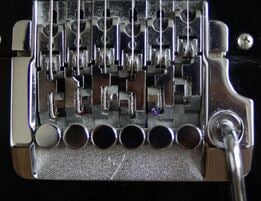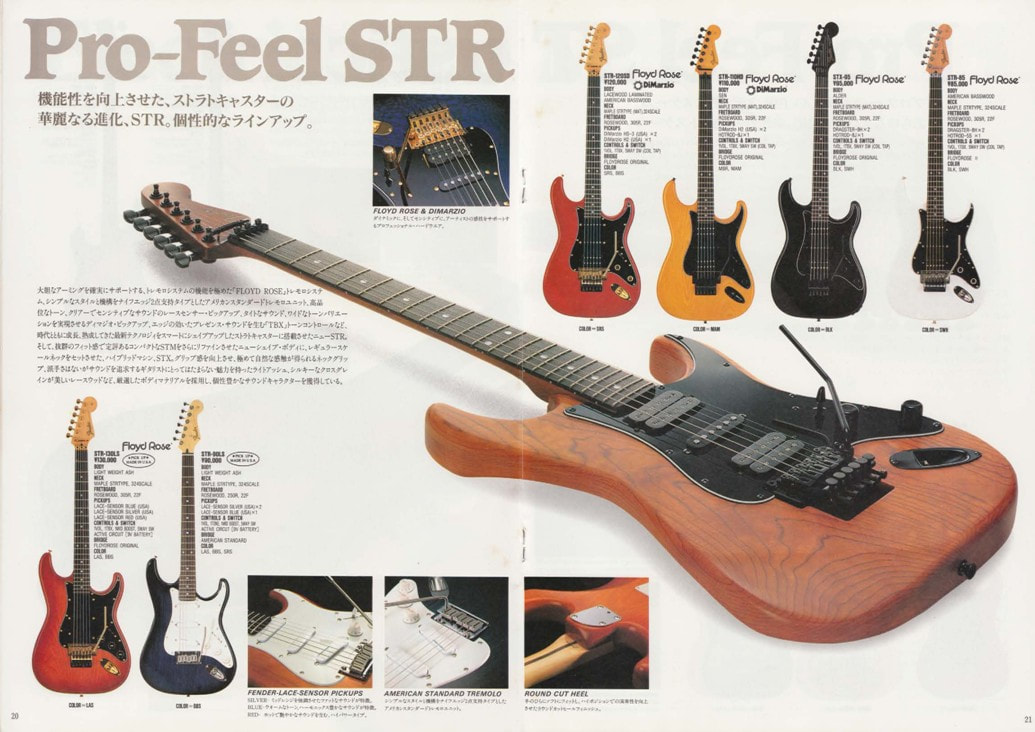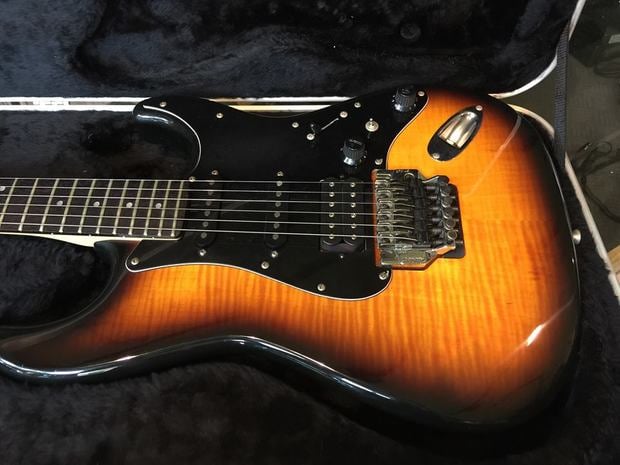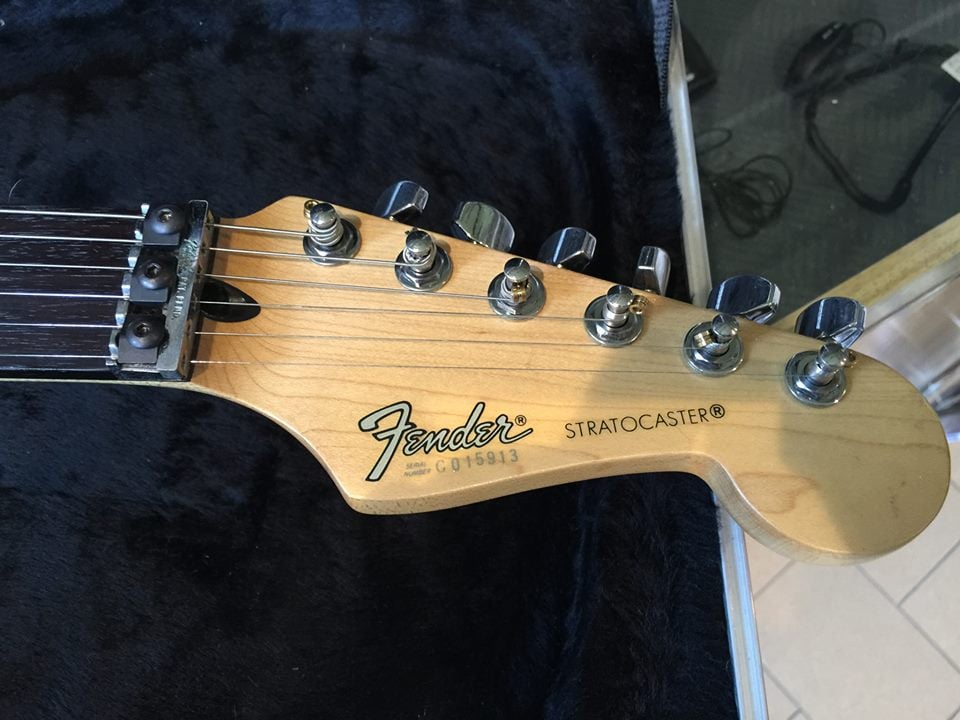In the first years that followed the Fullerton factory shutdown and preceded American Standard’s introduction, Fujigen not only supported Fender by manufacturing lots of guitars for the American market but also contributed to Stratocaster’s evolution through the introduction of super strat guitars that were in line with the growing use of the vibrato bar and with rock music carried to excess.
It’s important that Fender, at first, used the Squier brand to enter the market of super strats, they couldn’t have made these with the Fender name.
It’s important that Fender, at first, used the Squier brand to enter the market of super strats, they couldn’t have made these with the Fender name.
Contemporary Stratocasters
JAPANESE DOMESTIC MARKET
Contemporary Stratocasters appeared for the first time in the 1983 Japanese catalog under the Squier brand and were only for the internal market.
The first models initially had a "JV7xxxxx" serial number - although these guitars are not considered by music lovers and collectors real JV Stratocasters - after which followed those with the serial number starting with “SQ” (strangely!) and “E”. They were all characterized by a painted headstock with “Squier” and “Contemporary Series” logos, in addition to “by Fender” and “STRATOCASTER” decals in large letters, and were very different from the typical Stratocasters.
Although the alder body was the same as the classic JV’s, they were actually designed for metal lovers - "For the metalist," the catalog stated. There were at least thirteen different models, all of them characterized by a flat fretboard, medium jumbo frets, and many pickup combinations (humbucker Dragstar or single coil Hot Rod) and some had the butterfly string trees, while others did not.
The first models initially had a "JV7xxxxx" serial number - although these guitars are not considered by music lovers and collectors real JV Stratocasters - after which followed those with the serial number starting with “SQ” (strangely!) and “E”. They were all characterized by a painted headstock with “Squier” and “Contemporary Series” logos, in addition to “by Fender” and “STRATOCASTER” decals in large letters, and were very different from the typical Stratocasters.
Although the alder body was the same as the classic JV’s, they were actually designed for metal lovers - "For the metalist," the catalog stated. There were at least thirteen different models, all of them characterized by a flat fretboard, medium jumbo frets, and many pickup combinations (humbucker Dragstar or single coil Hot Rod) and some had the butterfly string trees, while others did not.
In addition to a 6-screw bridge with block saddles, a new tremolo system first appeared in this series: the Rox System, composed of the Upper Rox string clamp and the Bottom Rox bridge, equipped with roller saddles, in which the strings locked inside the steel tremolo block called End Rox.
EXPORT MARKET
Due to the closure of the Fullerton factory in 1985, and given the temporary unavailability of the American Stratocasters, those made in Japan were increasingly offered in European and US stores.
Until 1984 the only Contemporary Stratocasters were Squier branded and they were intended for Japanese territory only. However, in 1985, the first export Contemporary Strats appeared on the catalog, both Squier and Fender branded, all equipped with at least one humbucker.
The export Squier Contemporary Stratocaster, despite there being five of them, were rather rare. All equipped with at least one humbucker, they had a vintage style bridge.
Until 1984 the only Contemporary Stratocasters were Squier branded and they were intended for Japanese territory only. However, in 1985, the first export Contemporary Strats appeared on the catalog, both Squier and Fender branded, all equipped with at least one humbucker.
The export Squier Contemporary Stratocaster, despite there being five of them, were rather rare. All equipped with at least one humbucker, they had a vintage style bridge.
The Squier branded Contemporary Strats were joined by the Fender branded for the Western market. Among these are the Fender Contemporary Stratocasters and the Fender Contemporary Deluxe Stratocasters, made as exports from 1985 to 1988.
All the Contemporary Stratocasters had a black painted headstock. Japanese Strats with Fender System I or Kahler bridge, that did not have a painted headstock, were Standards.
“Fender” Contemporary Strats were guitars on which big Floyd Rose style bridges were mounted: the Fender System I (FS1), Fender System II (FS2), and Fender System III (FS3), all of them made by Schaller, and, at a later time, the Kahler Traditional Series Fulcrum Tremolo.
All the Contemporary Stratocasters had a black painted headstock. Japanese Strats with Fender System I or Kahler bridge, that did not have a painted headstock, were Standards.
“Fender” Contemporary Strats were guitars on which big Floyd Rose style bridges were mounted: the Fender System I (FS1), Fender System II (FS2), and Fender System III (FS3), all of them made by Schaller, and, at a later time, the Kahler Traditional Series Fulcrum Tremolo.
FENDER TREMOLO SYSTEM AND KAHALER BRIDGES
|
The Fender System I was identical to the Blade Shooter featured on the 1984 domestic Boxer Series Stratocasters and it was always paired with a string clamp near the nut. Its saddle heights were not individually adjustable, but it was nevertheless possible to regulate their intonation, and the bridge height could be modified through the two screws by which it was fixed to the guitar and that acted like a pivot. “System I with a conventional headstock locking system behind the nut is a 3-vise system that uses an allen wrench. The fine tuning, floating bridge ha two knife-edge pivots, height adjustable pivot posts, roller saddles and a snap-in adjustable tremolo arm.”
|
|
The Fender System II was very reminiscent of the Elite Stratocaster bridge (it makes smile that in the manual it was called a "vintage" bridge!). “System II, like System III, does not require ant tools to lock the strings. It has the patented cam actuated nut with a side-to-side locking action that does not affect the tuning when locked and is also height adjustable. The bridge features a true knife-edge pivot, specially designed, hardened steel saddles that are individually height adjustable and snap-in, adjustable tremolo arm.”
|
|
The Fender System III was more complex. It allowed the height of each saddle to be individually adjusted and could also be used as a fixed bridge. “System III... the ultimate, state-of-the-art, "no tools to lock" system has a patented, cam actuated nut with a side-to-side locking action that does not affect the tuning when locked and is also height adjustable. A new, free-floating bridge design incorporates smooth, centered pivot points to enhance accurate string bending. The low profile tuners can't get in the way. Specially designed saddles are individually adjustable and keep the strings on the saddles at all times.
|
The snap-in tremolo arm also locks the bridge to make it non tremolo. Allen Wrenches for height and intonation adjustments are hidden in the tremolo arm.”
|
The Kahler Traditional Fulcrum Tremolo was a fulcrum based tremolo designed as an alternative to the stock Fender tremolo system. “Kahler Traditional Series fulcrum tremolos adjust to you and your style (not the other way around). Our new bridge saddles allow you to set intonation, and string spacing all independently. Now you don't lose control of feel and sound. Our new roller saddle lock solidly o the tremolo mounting plate to insure solid harmonic transfer for superb tone and sustain.
|
You can also lock out any roller movement you prefer. Separate screw adjustment allows you to choose easy or resistant tremolo arm rotation. [...] Our "pro" traditional models include no wrench string lock as standard equipment.”
Comparison between string lock systems of the Superstrats
BOXER AND PRO FEEL SERIES
In 1984 the new domestic Boxer Series was developed as an evolution of the Contemporary Series and to bring Fenders to a new era. In fact, simultaneously with the production of the Contemporary export models, the Contemporary Series was replaced, for the Japanese domestic market, by the Boxer Series. Unlike the previous Contemporary domestic, the Boxer Series was Fender branded, like the exports.
These models featured modern specs such as high output pickups, TBX tone control and 22 frets. The medium scale was adopted for some models.
The bridge of these guitars could be the classic Vintage Style, the Blade Shooter Tremolo (identical to the Fender System I), the Fender System II or III or the Kahler Fulcrum Traditional Tremolo.
These models featured modern specs such as high output pickups, TBX tone control and 22 frets. The medium scale was adopted for some models.
The bridge of these guitars could be the classic Vintage Style, the Blade Shooter Tremolo (identical to the Fender System I), the Fender System II or III or the Kahler Fulcrum Traditional Tremolo.
Boxer Series was discontinued in 1988 and, in 1989, this series was replaced by the new Pro Feel Series. Like the Boxer series, it created an unprecedented view of the world of Fender. Improved playability in high positions was obtained by adopting 22 frets and a cut and deep neck heel with asymmetrical neck plate. Other features included new bridges such as Kahler, End Rox and the Floyd Rose licensed ExTrem. Pro Feel Stratocasters featured modern specifications to stand out from the vintage style Strats, such as Lace Sensors, Hot Rod, Dragstar, and Di Marzio HS-3 pickups. Medium and short scales were adopted for some models. The first HM Strats appeared in this series for the Japanese domestic market.
HM STRAT
|
Some years later the HM Series, made up of guitars with a decidedly more metal look, was born. These "Heavy Metal" Strats, that sported a slightly smaller basswood body, black hardware, headstock and plastics, and usually no pickguard, were designed by Dan Smith and Nick Sugimoto, a Japanese luthier who had worked for twenty-three years in R&D, custom guitar building and engineering at Fujigen factory. The Strat logo was designed by Mr. Kimura from Fujigen.
There were different HM Strats, each with a different pickup configuration (but that always included one or two humbuckers) and a floating bridge similar to the Floyd Rose and able to allow an exaggerated use of the vibrato bar. |
The first to enter the Fender catalog in 1988 were the Japanese HM Strat, followed in 1989 by the US HM Strat, and, a year later, by the new HM Strat made in Japan. They were all available in different and mostly bright colors.
The Kahler Spyder
|
The first guitars of this series, the 1988 Japanese HM Strats, were equipped with a Kahler Spyder Tremolo bridge. “The Spyder is one of our most innovative bridges. This Double Locking fulcrum style bridge offers maximum sustain with steel witness points and Kahler's own patented knife bolt hinging system. Wider stud spacing allows for easy retrofit to many guitars. The Spyder is Auto-Latch ready, and other options include finger-locking and non-locking saddle sets. The Spyder is durable and economical yet flexible enough to meet every players needs.”
The neck plate had a “Fender USA” engraving, a detail that created a lot of confusion because it erroneously implied that they were American guitars, in conjunction with the fact that the serial number frequently began with “E”, like the others Fender made in USA in the '80s. |
The following year production was moved to the United States. It’s not easy to distinguish the HSS type made in the USA from the Japanese one, as the "made in Japan" decal is not always present or reliable and as they are identical guitars, except for the Di Marzio and American Standard pickups in the American ones and some different finishes. Among the US HM Strat we should mention the HM Strat Ultra, with an ebony fretboard with triangular markers, Lace Sensor pickups and Kahler Spyder Tremolo
The Floyd Rose
|
In 1991 the HM Strat’s production returned to Japan; the new guitars were still equipped with the Di Marzio humbucker, but also with the Floyd Rose Original and Floyd Rose Pro bridges. In fact, at 1991 NAMM, Fender announced that Floyd Rose, the inventor of the locking tremolo system, joined exclusively with FMIC. Floyd said it best in a magazine interview at the NAMM show when he stated that “The first Floyd Rose tremolo system was invented and installed on my favorite guitar, a '57 Strat. Like so many of my friends at the time agreed, we didn't like our Fenders any less after installing my locking system. In fact, we liked 'em even more. Because of my love for the original Fender product, I'm the last guy in the world who would want to make any broad, sweeping changes to such a time-proven winner.”
|
Floyd also recalled that Fender was the first company that he approached after getting his first patent: “The people there at the time just weren't interested. But in the past few years, Fender has changed hands and, in the process, has recaptured the quality and innovation that made me go to them in the first place. I couldn't be happier that we are finally together.”
“There's a real difference between a tremolo designed by Floyd Rose himself, and the rest. The most popular tremolo bridge ever created,” as Fender advertised Floyd Rose systems. The Pro bridge had the same construction as the Floyd Rose Original, but the bridge plate is die-cast, rather than case-hardened steel, which provided a mellower tone. Also, the advert pointed out that it had a modified shape: “a lower profile to accommodate the right hand” and “wrenches and screws featured large SAE threads, for increased strength and longer life.”
Late '80s HM Series advertising with Greg Howe
US Contemporary Stratocaster
Finally, the US Contemporary Stratocaster were guitars designed by Fender as a modern evolution of the Stratocasters. Unfortunately not much is known about these guitars. They were assembled in U.S.A. using mostly Japanese components. Indeed, both the neck, without any decal indicating the origin, and the figured maple top and back body really look as if they were made in Japan.
These guitars featured a twenty-two fret fretboard, Gotoh tuning machines, contoured neck plate with the "Fender U.S.A." engraving and equipped with micro tilt, Kahler bridge with the locking nut, and a split-able humbucker at the bridge along with two single coils.
These guitars featured a twenty-two fret fretboard, Gotoh tuning machines, contoured neck plate with the "Fender U.S.A." engraving and equipped with micro tilt, Kahler bridge with the locking nut, and a split-able humbucker at the bridge along with two single coils.
US Contemporary Stratocaster (Courtesy of Davide Crippa)
Notes
Don't forget the Contemporary Strats made by the USA Custom Shop in the '90s, to which a separate chapter has been dedicated, and the 2020 "reissue" Limited Edition HM Strat.
Antonio Calvosa






























